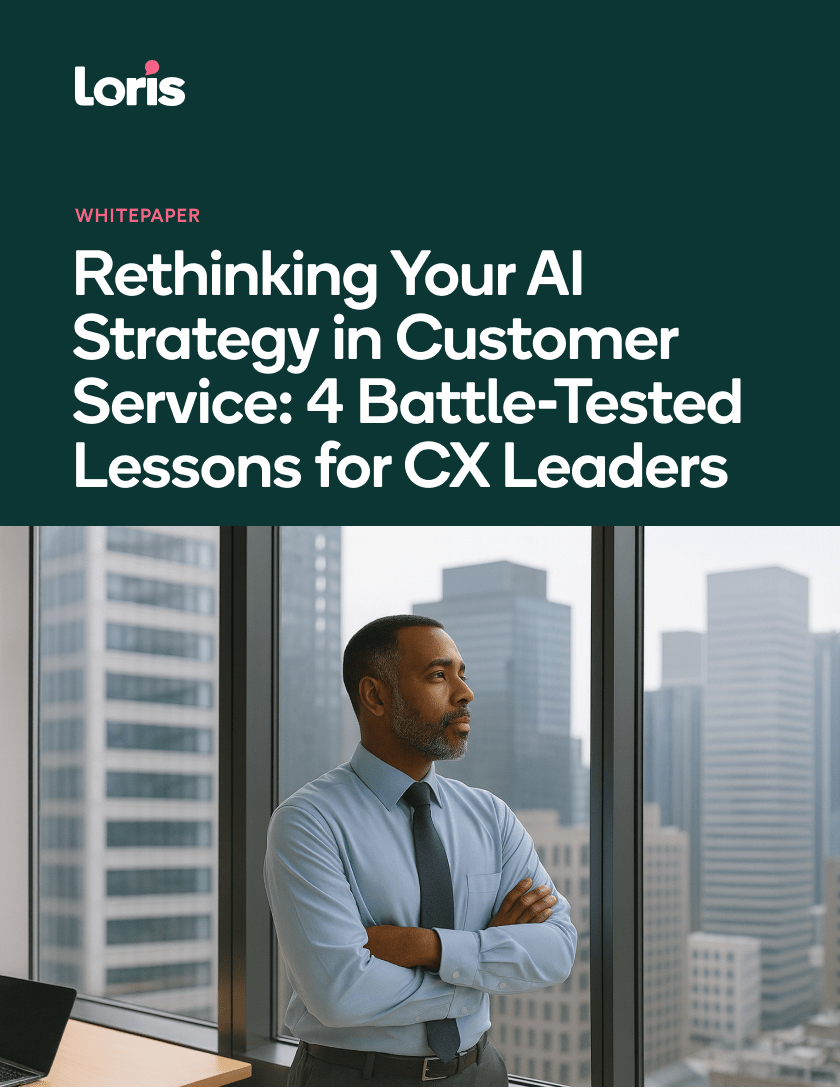
AI in CX is already a strategic necessity, setting apart leaders who proactively enhance customer experiences while laggards risk falling behind. Will you take the lead and leverage AI for personalized, proactive care, or continue reacting and face the consequences?
- When Customer Experience Meets Change: The AI Revolution
- AI Shouldn’t Be Your Strategy. Solving Customer Problems Should Be.
- The Risk of Going All-In Too Soon
- Automate What Matters: Finding the Right Fit for AI in Your Call Center
- Pitfalls of a ‘Tech-First’ Approach: Why Vision and Planning Matter
- Turning Conversations into Insights: The Future of CX Leadership
- Where to Start Building a Smarter, Not Harder, CX Operation
- Lead, Don’t Chase
- FAQ
When Customer Experience Meets Change: The AI Revolution
For years, traditional customer service in call centers meant long wait times, repeated questions, and inconsistent answers—mainly because most systems could only react once a customer reached out. This approach left customers frustrated and agents juggling endless routine requests. Outdated technology and limited insight into customer needs kept things stuck in place.
AI in CX changes the game. Companies using call center automation aren’t just fixing surface-level problems—they’re setting a new standard. AI-powered systems can spot issues before they blow up, handle repetitive tasks like password resets, and give instant, personalized support—no more making customers repeat themselves. This proactive, tailored approach sets leaders apart.
But the opposite is also true; standing still means falling behind. Some companies are pulling ahead, enjoying faster service and happier customers, while others risk higher costs, missed chances, and losing customers. AI in CX is no longer some far-off idea—it’s what gives businesses an edge right now. The real question: will you take the lead, or get left behind?
AI Shouldn’t Be Your Strategy. Solving Customer Problems Should Be.
There’s intense pressure on CX leaders to “do something with AI.” Boards are asking. CEOs are asking. Customers are asking. But investing in AI just to say you’ve invested is a mistake
AI should never be the goal. Improving customer experiences, streamlining operations, and reducing friction across customer journeys should be the goal. AI is simply a set of tools that, when deployed thoughtfully, can help you reach that goal faster.
Before throwing resources into the latest chatbot, generative model, or automation tool, CX leaders must first get clear on where AI can meaningfully impact their business:
- Where are your points of customer friction?
- Where are tedious manual processes slowing you down?
- Where are unnecessary contacts creating volume and cost?
When you use AI to surface and understand these gaps, you’re not just reacting to a technology trend—you’re actively improving your business.
The Risk of Going All-In Too Soon
The reality is that many AI solutions today are still evolving. Generative AI is powerful, but it’s not infallible. Without careful deployment, it can create customer confusion, amplify errors, or deliver tone-deaf experiences that damage trust
Too many brands jump headfirst into deploying AI-powered self-service without a clear understanding of customer needs—or without fixing underlying experience issues first. The result? Escalations skyrocket, customer satisfaction drops, and support costs increase rather than decrease. This is likely what led the firm Klarna to roll back their AI Agent after replacing 67% of their workforce in 2024.
Instead of rushing into full-scale automation, smart organizations use AI first to listen:
- Analyze 100% of conversations (not just a small sample) to detect emerging issues.
- Measure real sentiment across interactions, not just survey responses.
- Understand the true drivers behind customer contact.
- Identify manual tasks that can be automated without harming the customer experience.
This strategy allows brands to fix root causes, streamline their service design, and selectively automate where it makes the most sense.
Automate What Matters: Finding the Right Fit for AI in Your Call Center
Call centers have long faced the same frustrations: repetitive questions, long wait times, and agents worn down by simple requests that drain their energy for the tougher problems. As customer expectations keep climbing, sticking with yesterday’s manual processes just doesn’t work. The big question now is figuring out what to automate—and what should stay personal—so you deliver smooth customer journey automation without making your contact center feel cold or unapproachable.
The Automation Dilemma: Too Much, Too Little, or Just Right?
Automation in call centers sounds appealing because it offers faster responses and lower costs. But handing everything over to bots can backfire if you pick the wrong tasks. Customers still want empathy and creative problem-solving, especially when confusion, frustration, or high stakes are involved—think of a shopper disputing a lost package or someone asking about a suspicious charge.
So, where’s the balance? Start by using AI-powered insights to break down your current workflows. These platforms review every customer conversation, highlighting which tasks are repetitive and which need a human touch. For instance, Loris helped Calendly reduce costs by 23% and flagged conversations where agent empathy was needed, letting automation take care of the routine work.
What Should You Automate?
AI delivers the most value in call centers when it handles:
- Repetitive, low-value tasks: Password resets, order status checks, and appointment reminders are perfect for AI chatbots or voice assistants. This gives agents more time for tricky situations.
- Automated triage: Using an AI Agent for automated triage can save hundreds of hours every month by sending tickets to the right agents instantly, instead of sorting them using outdated logic. Even in cases where the AI Agent can’t handle the entire inquiry, it can speed up resolution by performing specific tasks like information gathering and authentication.
- Quality assurance and analytics: AI can score every AI and Human Agent interaction so you have an immediate look at how they are handling your customers. Having AI do the initial quality analysis provides greater breadth and consistency, so you can surface issues and coaching opportunities quickly.
When to Keep It Human
Not every step in the customer journey can be automated. AI can predict churn and spot shifts in mood, but it doesn’t always capture the subtlety of a real person. In retail, a customer upset about a late delivery wants someone to listen and fix the issue—not a generic apology from a bot. In financial services, a client worried about a possible fraud alert expects reassurance and expertise from a real person.
Leaders in call center automation recommend a blended approach: let AI handle the simple, more transactional interactions, but give agents the authority to jump in for high-stakes or emotional conversations. This model keeps satisfaction scores high, while keeping people involved for complex cases.
Avoiding the Trap of Over-Automation
It’s easy to get caught up in the excitement of new tech, but automating too much can break trust. Customers can feel disconnected if every interaction is scripted or handled by a machine. The best move? Use AI to boost efficiency and give agents better tools—like real-time coaching or instant access to information—while keeping the warmth and creativity that only people can provide.
Quick Wins for Smarter Automation
Opportunity | Automate with AI? | Keep Human?
|
Password resets | ✅ |
|
Order status updates | ✅ |
|
Handling complaints |
| ✅ |
Fraud investigation |
| ✅ |
Quality assurance scoring | ✅ |
|
Empathetic problem solving |
| ✅ |
By targeting automation where it makes a real impact, your call center becomes more agile, more efficient, and—most importantly—more human where it matters most. Customer journey automation works best when it’s smart, selective, and always focused on what your customers truly need.
Pitfalls of a ‘Tech-First’ Approach: Why Vision and Planning Matter
Charging ahead with AI in CX (Customer Experience) without a clear vision almost always leads to disappointment. The appeal of automating call center interactions and delivering personalized service at scale is strong, but rushing in with a “tech-first” mindset often creates more problems than it solves.
Supporters of rapid AI adoption highlight impressive results. For example, Klarna announced they had replaced 2/3 of the customer service operations with an AI Agent, saving millions. This shook the industry and led to a ton of pressure of CX leaders to do the same. Only in February 2025, Klarna announced they were rolling back that original effort and rehiring human customer service agents.
When you see headlines and amazing results, it’s hard to overlook them. And the pressure to match industry leaders is intense. But before you roll out new AI tools—chatbots, predictive analytics, or virtual assistants— you must consider: What do customers actually need? How does this fit with our existing processes? Is the team prepared for these changes?
Plenty of evidence shows the risks of letting technology lead the way. Dropping AI into the call center without a clear plan often results in:
- Confusing customer journeys that frustrate users—such as chatbots that don’t understand requests or systems that send people in circles.
- Loss of customer trust, especially when AI feels cold or makes mistakes with sensitive issues, like when humanlike bots have to deliver bad news or handle private financial information.
- Systems becoming too complicated to manage, making it tough to connect with existing CRMs or older platforms.
- New sources of frustration, including inconsistent experiences across channels or a lack of empathy in emotionally charged conversations.
Leaders who rely on data know that strategy should come before technology. Top companies in retail and financial services aren’t simply throwing AI at every problem. They build their approach around customer needs and day-to-day realities. Starbucks, for instance, uses Deep Brew and predictive analytics to personalize marketing—but only after aligning with their brand values and what customers expect.
A few practical moves can help avoid falling into the tech trap:
- Map out the customer journey to spot pain points and figure out where AI can actually help.
- Set clear business goals—such as cutting down call times or boosting first-contact resolution—before bringing in new tools.
- Test AI in low-risk settings, learn from real customer interactions, and adjust quickly based on feedback.
- Make transparency a priority by clearly letting customers know when they’re dealing with AI or a human agent, which helps build trust.
Leaders who bring AI into CX with careful planning and a clear sense of purpose unlock the possibility of proactive, truly personalized service—without falling into the common traps of a rushed rollout. Those who let strategy guide technology, rather than the other way around, will be best positioned to deliver lasting results.
Turning Conversations into Insights: The Future of CX Leadership

Data is more than a byproduct of customer service—it’s the currency of leadership. The numbers back this up. When Calendly brought in Loris, they cut costs by 23% and saw measurable improvements in both average handle time and customer satisfaction. This goes beyond automating repetitive tasks. Conversation intelligence helps spot problems before they escalate and makes every interaction feel personal. Picture this in a busy retail environment—a single delayed shipment can make or break a customer relationship. With tools like Loris Customer Insights, leaders get a complete view of every conversation and capture the Voice of the Customer—no more sampling, no more guesswork.
In sectors like financial services, a missed complaint can trigger compliance headaches. In retail, trends can shift overnight. The breadth and speed that AI provides becomes a real strategic advantage. Predictive customer satisfaction scores and root cause analysis become part of your daily toolkit—not just something you look at once a year.
Customer journey automation is moving toward being proactive. As more companies adopt AI-powered platforms, those out in front will be the ones who act on their data, closing the gap between insight and action. Only 39% of organizations manage to turn data-driven insights into lasting competitive advantage. The path forward is clear: lead with insight, not just technology. That’s how you set the pace for customer experience.
Where to Start Building a Smarter, Not Harder, CX Operation
Here’s what leading organizations are doing right now:
- Using AI to find hidden sources of customer dissatisfaction: Not every “negative” conversation is about the agent. In fact, research shows 70% of negative sentiment is directed at company policies and products, not agents
. Knowing the difference is critical. - Reducing unnecessary contacts: AI can surface FAQs and friction points that, once addressed proactively, reduce inbound volume without sacrificing service quality
. - Automating tedious QA processes: Instead of manually grading random customer interactions, AI can intelligently score every conversation for quality, providing richer insights and freeing up human time for more valuable coaching
. - Spotting and fixing product or service gaps faster: Emerging issue detection means you can see a problem days—or even weeks—before it snowballs
. - Scaling customer intelligence across the company: Rather than customer insights living in siloed reports, brands are using AI to turn service conversations into a centralized knowledge hub
.
Lead, Don’t Chase
AI will reshape CX whether we like it or not. The brands that thrive won’t be the ones that chase every new tool. They’ll be the ones that start with a vision, use AI to deeply understand their customer experience, and apply it thoughtfully to remove friction, empower agents, and delight customers.
If you want to be one of those leaders, start now: not by buying an AI product, but by getting smarter about where and how you deploy AI to drive true business value.
The future is coming fast. Lead it—or get left reacting.
FAQ
How is AI changing customer experience in call centers?
AI transforms customer experience in call centers by enabling a proactive, more intelligent approach. It handles repetitive tasks, anticipates customer needs, and offers instant support, reducing the frustration of long wait times and repeated questions.
What are some successful implementations of AI in call centers?
Companies like Calendly have used AI to increase insight while reducing unnecessary manual steps. This has resulted in a reduction in cost per call and greater understanding of how and where to improve the customer experience. Read more in their case study.
Why are traditional call centers falling short?
Traditional call centers often operate reactively, leading to long wait times and customer frustration due to repetitive questioning. This model overwhelms agents with simple, routine tasks, preventing them from focusing on more complex interactions.
What benefits can predictive analytics provide in call centers?
Use AI predictive analytics enables call centers to anticipate customer needs by spotting patterns in data. This approach can flag issues before they escalate, improving retention rates and loyalty by addressing potential problems proactively.
Which tasks are ideal for AI-driven automation in call centers?
AI is best suited for repetitive, low-value tasks such as password resets, order status checks, and appointment reminders. An easy way to uncover these is to look as conversation metadata like number of interactions, customer sentiment, and other conversation markers. Even where inquiries can’t be fully automated, AI Agents can handle ticket triage and quality assurance, allowing human agents to focus on more complex and emotionally charged interactions.
When should human agents be prioritized over AI in customer interactions?
Human agents are essential when dealing with high-stakes, overly complex, or emotionally-charged conversations, such as handling customer complaints, fraud investigations, and situations requiring empathy and creative problem-solving.
What are the risks of a ‘tech-first’ approach to AI implementation?
A tech-first approach can lead to confusing customer experiences, loss of trust, and overly complex systems. Without a clear strategy, companies risk over-relying on technology and neglecting customer needs and expectations.
How can companies effectively integrate AI into their call centers?
Companies should map out customer journeys, set clear business goals, and test AI in low-risk environments. Balancing AI and human agents ensures efficiency while maintaining personalized customer experiences.
What role does AI-generated data play in advancing CX leadership?
Data is crucial for CX leadership, providing insights that drive proactive customer care and inform business strategies. Tools like Loris enable companies to use AI to turn customer interactions into data-driven insights and actionable strategies, enhancing customer satisfaction and operational efficiency.
